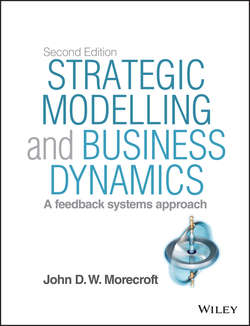Читать книгу Strategic Modelling and Business Dynamics - Morecroft John D. - Страница 18
На сайте Литреса книга снята с продажи.
CHAPTER 1
The Appeal and Power of Strategic Modelling
The Puzzling Dynamics of International Fisheries
ОглавлениеBy now I hope your curiosity about modelling is stirred, but before probing the basic concepts and tools used by system dynamics modellers, I want to show you a model, a small model, designed to address an important contemporary issue facing society. I will explain its main assumptions, demonstrate some simulations and then give you the opportunity to run the simulator for yourself.
The topic is fisheries. The problems of overexploitation facing international fisheries are well known, widely reported in the press and a subject of government policy in many nations. The performance of international fisheries is indeed puzzling. Fish naturally regenerate. They are a renewable resource, in apparently endless supply, providing valuable and healthy food for billions of consumers and a livelihood for hundreds of thousands of fishing communities worldwide. The fishing industry has been in existence since the dawn of civilisation and should last forever. Yet fish stocks around the world are volatile and some are even collapsing. Once rich fishing grounds such as Canada's Grand Banks now yield no catch at all. Stocks in other areas, such as the English Channel, the North Sea and the Baltic, are in terminal decline.
The issue is powerfully expressed by environmental journalist Charles Clover (2004) in his acclaimed book The End of the Line. Here is an excerpt from Chapter 1:
Fish were once seen as renewable resources, creatures that would replenish their stocks forever for our benefit. But around the world there is evidence that numerous types of fish, such as the northern cod, North Sea mackerel, the marbled rock cod of Antarctica and, to a great extent, the west Atlantic bluefin tuna, have been fished out, like the great whales before them, and are not recovering … The perception-changing moment for the oceans has arrived. It comes from the realisation that in a single human lifetime we have inflicted a crisis on the oceans greater than any yet caused by pollution. That crisis compares with the destruction of the mammoths, bison and whales, the rape of rainforests and the pursuit of bushmeat. It is caused by overfishing.
(from The End of the Line by Charles Clover, published by Ebury. Reprinted by permission of The Random House Group Ltd and Charles Clover.)
Figure 1.3 Pacific sardine catch (top) and North Sea herring catch (bottom) from Fish Banks debriefing materials (Meadows et al., 2001)
Source: Nichols (1999).
Figure 1.3 shows evidence of overfishing from two real fisheries. This kind of time series data is a useful focus for model building because it contains the dynamics of interest. The top chart shows the Pacific sardine catch in thousands of tonnes per year over the period 1916–1996. The annual catch grew remarkably between 1920 and 1940, starting at around 50 thousand tonnes per year and peaking at 700 thousand tonnes per year – a 14-fold increase. Over the next four years to 1944, the catch fell to 500 thousand tonnes per year, stabilised for a few years and then collapsed dramatically to almost zero in 1952. Since then it has never properly recovered. The bottom chart shows a similar story for the North Sea herring catch in the period 1950 to 1998. However, in this case, following a collapse between 1974 and 1979, the fishery did recover in the 1980s and early 1990s with an average annual catch around 600 thousand tonnes per year – similar to the catch in the 1950s and 1960s.
Why does overfishing happen? We can be sure that no fishermen set out with the deliberate intention of depleting fisheries and wrecking their own livelihoods. Yet this outcome has been repeated in fishing communities around the world.10 A good explanation is to be found in a fisheries gaming simulator called Fish Banks, Ltd (Meadows et al., 2001; Meadows and Sterman, 2011). Since I am not an expert on fisheries, I will base my model on this popular simulator. Fish Banks has been used to teach principles of sustainable development to audiences that include politicians, business leaders and government policy advisers as well as fishing communities and high school students. Incidentally, it is no coincidence that the lead designer and author of Fish Banks, Dennis Meadows, was also a principal investigator in the Limits to Growth study. Fish Banks has proven to be a potent metaphor for sustainable development in many industries and enterprises, including the world itself viewed as a huge socio-economic enterprise.
Figure 1.4 shows the Fish Banks game board and its imaginary fishery. There is a region of ocean, close to land, containing a single species of fish. Fish regenerate as a function of the existing population. The local fishing community buys ships from the shipyard and takes them to sea to harvest fish. The total catch depends on the number of ships, the fish population and other factors, such as the weather. In the game, as in real life, the fish population is not known accurately, although it can be estimated. Also, in the game, as in real life, the process of fish regeneration is not fully understood by those in the system (players or fishermen). Regeneration is related to the (unknown) fish population, but the relationship is complex and may involve other external factors.
Figure 1.4 An imaginary fishery – the game board of the original FishBanks, Ltd
Source: Meadows, et al., 2001
10
Clover describes the poignant scene at Lowestoft in recent years: the unrepaired doorways and shabby 1930s office buildings on the seafront, symbols of economic collapse. This town was once among England's greatest fishing ports, famous the world over, with a history spanning 600 years.
